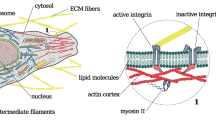Abstract
Cell migration can be characterized by two independent variables: the speed,v, and the migration angle, ϕ. Each variable can be described by a stochastic differential equation—a Langevin equation. The migration behaviour of an ensemble of cells can be predicted due to the stochastic processes involved in the signal transduction/response system of each cell. Distribution functions, correlation functions, etc. are determined by using the corresponding Fokker-Planck equation. The model assumptions are verified by experimental results. The theoretical predictions are mainly compared with the galvanotactic response of human granulocytes. The coefficient characterizing the mean effect of the signal transduction/response system of the cell is experimentally determined to 0.08 mm/V sec (galvanotaxis) or 0.7 mm/sec (chemotaxis) and the characteristic time characterizing stochastic effects in the signal transduction/response system is experimentally determined as 30 sec. The temporal directed response induced by electric field pulses is investigated: the experimental cells react slower but are more sensitive than predicted by theory.
Similar content being viewed by others
Literature
Alt, W. 1990. Correlation analysis of two-dimensional locomotion paths. InLecture Notes in Biomathematics. Biological Motion, W. Alt and G. Hoffmann (eds), pp. 254–268. Berlin, Heidelberg: Springer Verlag.
de Boisfleury-Chevance, A., B. Rapp and H. Gruler. 1989. Locomotion of white blood cells: A biophysical analysis.Blood Cells 15, 315–333.
Dunn, G. A. and A. F. Brown. 1987. A unified approach to characterizing cell motility.J. Cell Sci. Suppl. 8, 81–102.
Franke, K. and H. Gruler. 1990. Galvanotaxis of human granulocytes: electric field jump studies.Eur. Biophys. J. 18, 335–346.
Franke, K. and H. Gruler. 1992. Directed cell movement in pulsed electric fields. To be published.
Gruler, H. 1984. Cell movement analysis in a necrotactic assay.Blood Cells 10, 107–121.
Gruler, H. and B. Bültmann. 1984. Analysis of cell movement.Blood Cells 10, 61–77.
Gruler, H. and Nuccitelli. 1986. New insights into galvanotaxis and other directed cell movements. InIonic Currents in Development, R. Nuccitelli (ed.), pp. 337–347. New York: A. R. Liss Inc.
Gruler H. and A. de Boisfleury-Chevance. 1987. Chemokinesis and necrotaxis of human granulocytes: the important cellular organelles.Z. Naturforsch. 42c, 1126–1134.
Gruler, H. 1988. Cell movement and symmetry of the cellular environment.Z. Naturforsch. 43c, 754–764.
Gruler, H. 1989. Biophysics of leukocytes: neutrophil chemotaxis, characteristics, and mechanisms. InThe Neutrophil: Cellular Biochemistry and Physiology, I. Hellett (ed.), pp. 63–95. Boca Raton, Florida: CRC Press Inc.
Gruler, H. 1990. Chemokinesis, chemotaxis and galvanotaxis. Dose-response curves and signal chains. InLecture Notes in Biomathematics. Biological Motion, W. Alt and G. Hoffmann (eds), pp. 396–414. Berlin, Heidelberg: Springer-Verlag.
Gruler, H. and K. Franke. 1990 Automatic control and directed movement.Z. Naturforsch. 45c, 1241–1249.
Gruler, H. and N. A. R. Gow. 1990. Directed growth of fungal hyphae in an electric field.Z. Naturforsch. 45c 306–313.
Gruler, H. and R. Nuccitelli. 1991. Neural crest cell galvanotaxis: new data and novel approach to the analysis of both galvanotaxis and chemotaxis.Cell Mot. Cytoskel. 19, 121–133.
Rapp, B., A. de Boisfleury-Chevance and H. Gruler. 1988. Galvanotaxis of human granulocytes. Dose-response curve.Eur. Biophys. J. 16, 313–319.
Risken, H. 1984.The Fokker-Planck Equation. Heidelberg Springer Verlag.
Scharstein, H. and W. Alt. 1990. The influence of discrete position measurements on the correlation analysis of 2-dimensional tracks. InLecture Notes in Biomathematics. Biological Motion, W. Alt and G. Hoffmann (eds), pp. 278–280. Berlin, Heidelberg: Springer Verlag.
Stokes, C. L., D. A. Lauffenburger and S. K. Williams. 1990. Endothelial cell chemotaxis in angiogenesis. InLecture Notes in Biomathematics. Biological Motion, W. Alt and G. Hoffmann (eds), pp. 442–452. Berlin, Heidelberg: Springer Verlag.
Tranquillo, R. T. and D. A. Lauffenburger. 1987. Stochastic model of leukocytes chemosensory movement.J. math. Biol. 25, 229–262.
Tranquillo, R. T., S. H. Zigmond and D. A. Lauffenburger. 1988. Measurement of the chemotaxis coefficient for human neutrophils in the under-agarose migration assay.Cell Mot. Cytoskel. 11, 1–15.
Trinkaus, J. P. 1984.Cells into Organs. Englewood Cliffs, New Jersey: Prentice Hall Inc.
Wiener, N. 1961.Cybernetics: Or Control and Communication in Animal and the Machine. Cambridge: MIT Press.
Wilkinson, P. C. 1982.Chemotaxis and Inflammation. London: J. & A. Churchill.
Zigmond, S. H. 1977. Ability of polymorphonuclear leukocytes to orient in gradients of chemotactic factors.J. cell Biol. 75, 606–616.
Author information
Authors and Affiliations
Rights and permissions
About this article
Cite this article
Schienbein, M., Gruler, H. Langevin equation, Fokker-Planck equation and cell migration. Bltn Mathcal Biology 55, 585–608 (1993). https://doi.org/10.1007/BF02460652
Received:
Revised:
Issue Date:
DOI: https://doi.org/10.1007/BF02460652




